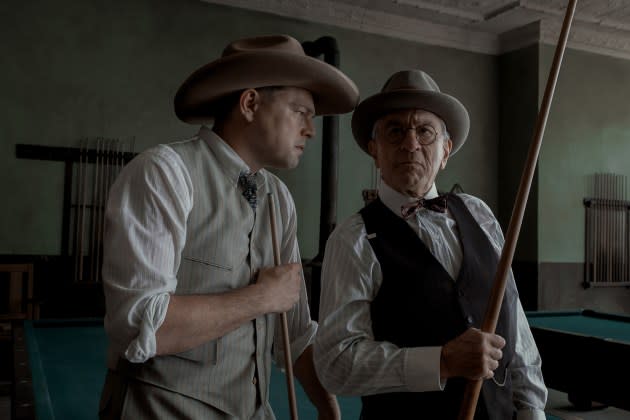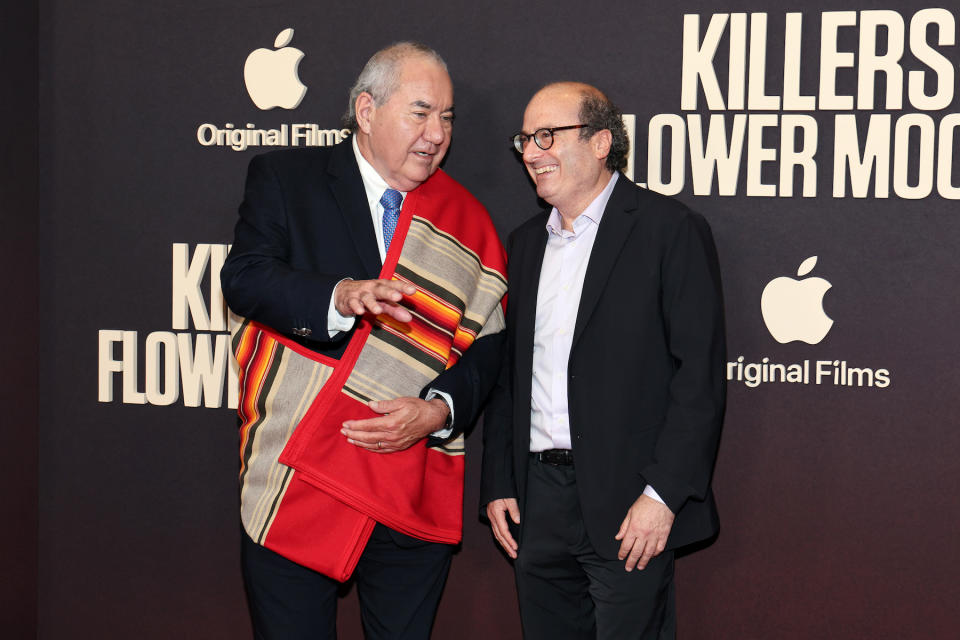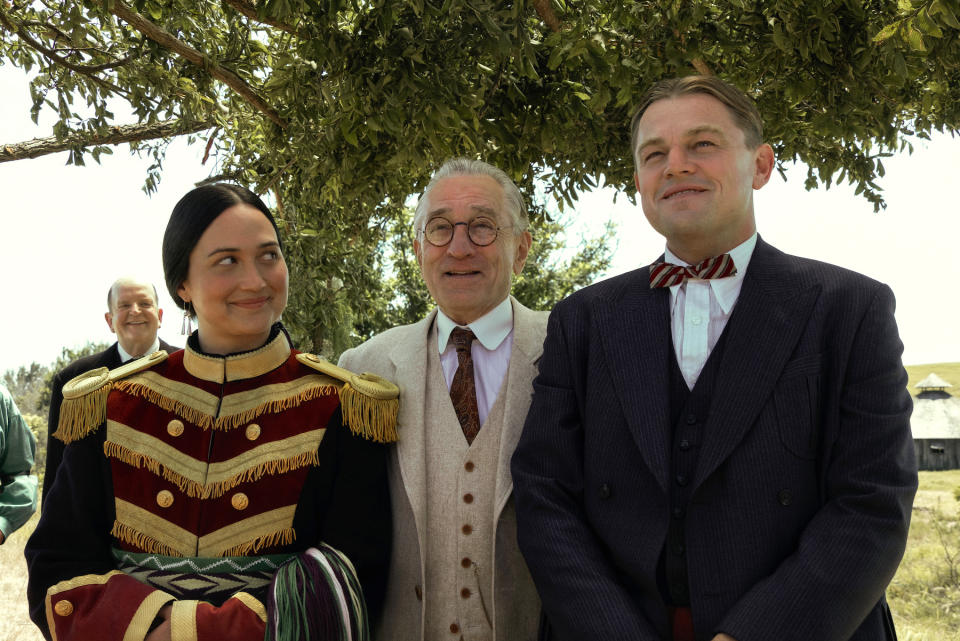Why ‘Killers of the Flower Moon’s’ Reign of Terror Is Still Felt Today
- Oops!Something went wrong.Please try again later.
- Oops!Something went wrong.Please try again later.
- Oops!Something went wrong.Please try again later.

Before he wrote the book Killers of the Flower Moon, author David Grann paid a visit to Oklahoma and the Osage Nation in 2012. He found himself in the local museum looking at a big panoramic photo of the Osage tribe and some white settlers. But a panel was missing from the photo; he asked the museum director Kathryn Red Corn why. “I’ll never forget what she said,” Grann recalls today. “She pointed to the missing section and said the devil was standing right there.”
Grann says Red Corn then went down to the basement and showed him the missing piece, which had William K. Hale peering out from the corner. Hale was one of the architects of a brutal chapter in history known as the Osage Reign of Terror. (Robert De Niro plays Hale in the new Martin Scorsese movie, and gives a subtle, classic, and deeply creepy performance.) The crimes took place in the 1920s when the tribe, newly flush with wealth from the discovery of oil on its territory, faced a brutal series of murders, many of which were never solved.
More from Rolling Stone
Greta Thunberg Was Targeted for an Octopus. Then Israel Chimed In
Errol Morris Talks Chaos and Conspiracy With John le Carré, and Defends His Steve Bannon Film
“Very rarely does a book have an origin story, but this one really did,” Grann recalls. “I couldn’t stop thinking about the photo and how the Osage are haunted by what happened. And yet so many people, including myself, have never learned this history. We have never been taught it. We had erased it. So I began the book really to try to address my own ignorance.”
The movie version of Killers has rightly been called “a masterpiece.” It’s a mystery, a Western, a story of betrayal, and a complete indictment of the American myth. It’s also a story about greed and systemic racism and tells the bloody origin stories of the oil business and indirectly, the climate crisis. We caught up with Grann to get his thoughts on the adaptation.
I was struck watching the movie that in some ways Killers of the Flower Moon is a parable about the climate crisis, or at the very least an early warning sign about the dangers of the oil industry. What do you think of that theory?
So there’s two sides to it. Because the Osage maintained control of vast oil deposits, it brought them extraordinary wealth. When you interview many Osage today, they talk about the many gifts of that wealth, the levels of education and the ability to travel. But as an Osage chief at the time said, “The oil money was both a blessing and a curse.” The curse was it brought in all these rapacious settlers. It brought in enormous corruption, and it ultimately culminated in the systematic murders of many members of the Osage Nation.

It’s partially an origin story for an industry that helped shape the nation, but it doesn’t seem like the companies tried to put a stop to the violence…
Yes. In the case of the Osage, it’s important to mention many of the oil barons who were getting extraordinarily wealthy from these leases to drill in Osage territory. Many of the names familiar to us first made their fortune in these lands: the Getty and Sinclair families, and the Phillips brothers from Conoco. While I never found any evidence directly implicating any of them in murders, what was very striking to me is that during the Osage Reign of Terror, I could not find any record of them ever commenting. These murders couldn’t be ignored. There was a bombing in the middle of town. The oil barons were still attending these auctions to bid on leases. So at a very minimum, they were complicit in their silence while they were getting extraordinarily wealthy.
Isn’t that part of the story of the climate crisis and oil industry too — looking away and making money while ignoring the harmful consequences?
Clearly the world in which we now live in today is a byproduct of the oil industry and all its implications on the environment. For a long time it was a little bit like cigarettes, you could turn away and pretend that the negative effects weren’t happening, and then at a certain point the signs are unmistakable. We’re living through the unmistakable signs today.
De Niro gives an incredible performance as King Hale. His calculated gaslighting of so many people struck me as representational of the oil industry as well.
Well, the parallel there is a certain ideology that Hale represented, and that a lot of rapacious industries can represent, which is this idea that you are bringing progress — and that this progress can’t be stopped. The sin is cloaked in goodness, and that was certainly the case with Hale, pretending to be the friend of those he was plotting against. He embodied that frontier mentality of manifest destiny. For your parallel to the oil industry, you could see some parallels there as well: that oil is the representation of this society that is going to bring enormous wealth and progress, while ignoring the devastating consequences.
It’s Goodfellas in Oklahoma in many ways, too. It really felt like these guys are just gangsters.
Well, it was a criminal enterprise. What’s interesting in the film is it really hones in on Hale and the henchmen. In many ways he’s like a mob boss, but in the cloak of a settler, and with a perverse Christian theology that he espouses while he’s plotting to kill. One of the things that is important to understand about the Osage Reign of Terror, and something that the movie suggests, is that there was this much deeper conspiracy that the FBI never exposed.
To understand these crimes you need to understand that this was less a story about who did it than who didn’t do it. It really was about this culture of killing in which many people were participating. There were many ordinary citizens who were carrying out these murders. Doctors who were ministering poisons, you had businessmen and lawmen who were on the take, and you had many others who were complicit. It really was systemic and structural. If you’re going to understand the Osage Reign of Terror that’s what you really need to take away from it.
One of the scenes that really struck me at the end was when the film switches to the radio play, which actually happened, right?
Yeah. There was really a radio play that the FBI orchestrated to burnish its reputation.
What did you make of Scorsese himself coming on camera for that scene? I found it very powerful.
Yeah, I did too. I never spoke to Scorsese about this, so this is my own interpretation. The reason it’s in the book is that it really gets at this idea of how stories get told. For a long time, the FBI and J. Edgar Hoover offered a sanitized version of what had happened, and never disclosed that there really was this much deeper and darker conspiracy that the Bureau never exposed. By showing this radio play, with these white actors with these very racist fake accents pretending to be Native Americans, it gets at the way this story was not just told, but mistold and misremembered. My own interpretation of Scorsese breaking that fourth wall at the end is his own sense of moral responsibility in trying to tell this story.
What has the Osage reaction been to the film?
I never like to speak for other people. Each individual probably has a different reaction. But the reaction I’ve heard, you don’t want to say positive, because it’s just such a devastating story. I saw a screening in Tulsa with many members of the Nation, and I’ve been to other screenings where some people may laugh in moments, but in that Tulsa screening there was no laughing. People watching that film were watching their ancestors be murdered.
In the most insidious of ways too, right? That’s what is so awful about it all. It’s not thieves coming to take your stuff — it’s marrying you and weaseling a way into your families, and then murdering you. It’s a very intimate crime.
That was just so deeply unnerving about these crimes, because they were inheritance schemes involving this very intimate level of betrayal. They had people marrying into families while pretending to love you and simultaneously, systematically plotting to kill you and sometimes even the children you have with that person. I could never fully fathom what it must’ve been like for Mollie Burkhart when she realized the man who she thought she had loved, whom she thought had loved her, had been plotting to kill her.

Last time we spoke about Killers of the Flower Moon you told me that in many ways we are all complicit. I think that’s what led me to the climate crisis argument, because of course in many ways we’re all complicit in that, too. It’s the theme that runs through this entire story.
It does, and often, whether in the past or in the present, and even with my newest book The Wager, in exploring these similar themes about how history is written and erased, but also about these systems of complicity and how for large-scale crimes to take place they require many people willingly going along with those systems, sometimes being complicit when they’re not even thinking about it. That hints at the climate crisis, where we are enjoying some of the luxuries that come along with the oil production and not thinking about the future.
The film draws parallels to the Tulsa race massacre. The film very effectively underscores the white supremacy at play. When the Ku Klux Klan are marching down the street, unmasked, one of them is a town leader and Leo’s character casually says hello.
Yeah. That’s true, the figure depicted in the movie was a KKK leader at that time. It is also the fact that these crimes were perpetrated in the 1920s, and at that very same time period only 60 miles away was the Tulsa race massacre. These crimes both had elements of envy and greed, but ultimately what really unites them was that they both involved this systematic dehumanization of another people. Those kinds of large-scale crimes can’t take place without that. If you really want to capture the attitudes of the time, one of the killers of the Osage gave testimony, and I’m paraphrasing, “We don’t see killing an American Indian today any different than we did in the 1700s.”
One of the things that’s also important to understand about the rapacious nature of these crimes and some of the parallels when we’re talking about today is that we are in modern times. We aren’t talking about colonial times, we are talking about the 20th century. When I was researching Killers of the Flower Moon, it was less than a century ago.
These people are not unfamiliar to us at all. These could be great-grandfathers or even grandfathers, depending on how old you are. This is not that far back at all.
In the case of the Osage Reign of Terror, you have descendants of the murderers who still hold headrights to this day. They’re still receiving grant money. There is a legacy to these crimes as well. When I met with the granddaughter of Mollie Burkhart, who is so central in the movie and central in the book, she took me to the cemetery where so many of her relatives are buried, many of them murdered. I remember her saying something like, “I didn’t get to grow up with cousins.” When I talked to her you really got a sense of how this history still reverberates today. This is still living history.
Best of Rolling Stone

